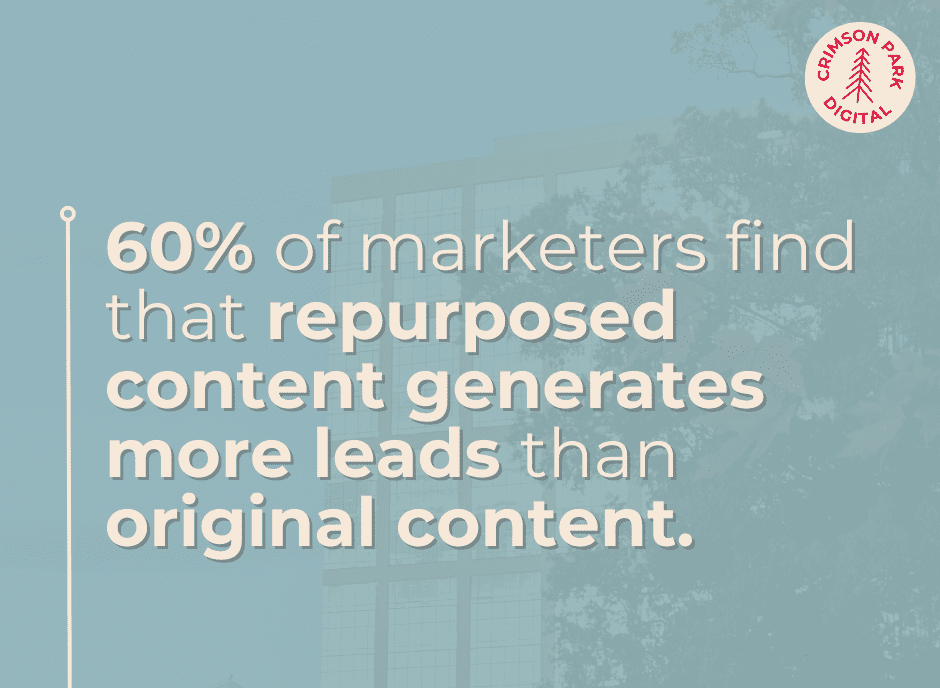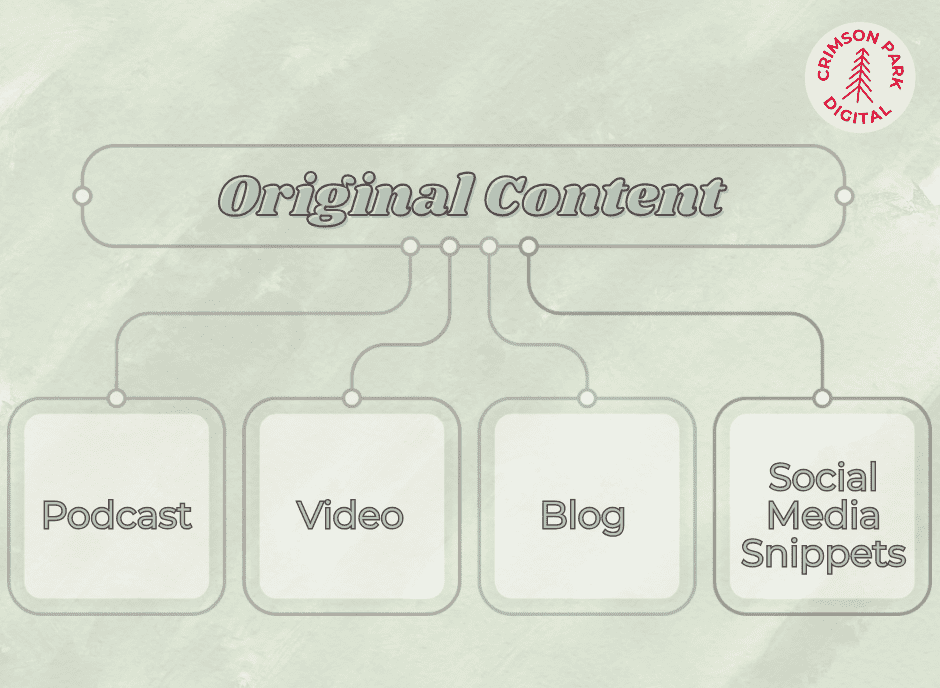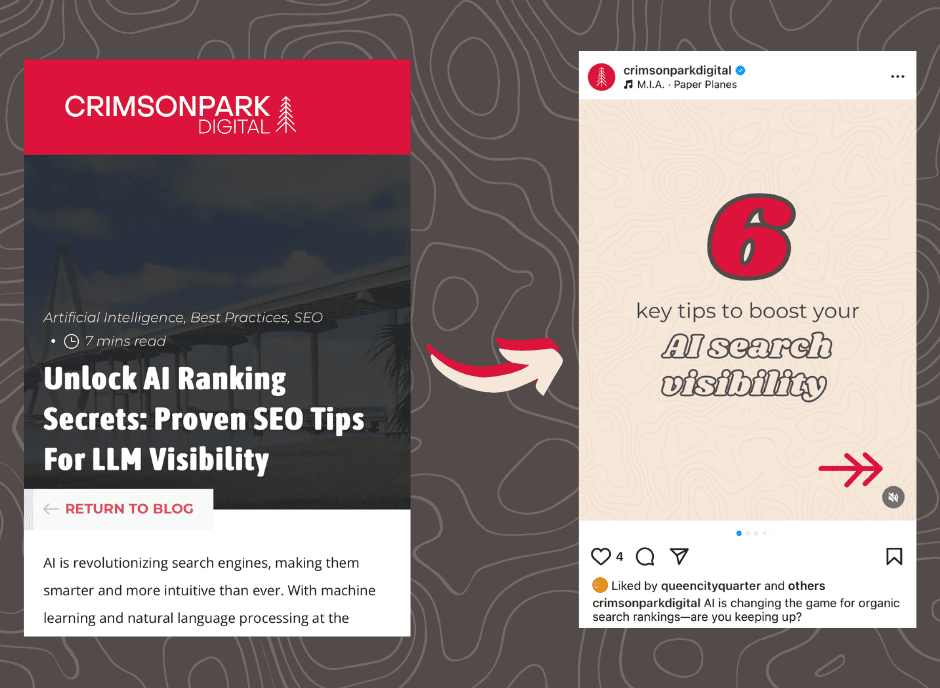Why Bother Repurposing?
Because content takes time, and good content takes a lot of time. Repurposing helps you:
1. Get Found More Often
Turning one blog post into a video, infographic, or podcast episode helps you show up in more places. More formats = more chances to be discovered. Plus, refreshing old content with new formats keeps it relevant in search engines. It’s a win-win for your SEO strategy. When your content shows up in different formats across various platforms—whether it’s Google, YouTube, TikTok, or LinkedIn—you’re widening your net. A single topic might appeal to someone in written form, while someone else might prefer a quick how-to video. That same topic, shared across three platforms in three different ways, multiplies your visibility and gives you a stronger presence without reinventing the wheel. This strategy sits at the intersection of content marketing and search engine optimization, helping your content work harder across channels.
2. Meet People Where They Are
Not everyone likes reading. Some scroll Instagram, some binge podcasts, some just want a quick visual summary. Repurposing your content into different styles helps you connect with different audiences in the way they actually want to consume it. This is especially important when thinking about accessibility. A video might work for visual learners, while an audio format helps commuters or multitaskers. Repurposing your content for multiple learning styles and consumption habits means you’re not leaving engagement on the table. It’s also a way to make your content more inclusive and reach different age groups, industries, and lifestyles.

3. Save Time
Creating from scratch every time is exhausting. Repurposing cuts down production time and makes it easier to keep content flowing without burning out your team. Think of your content as an asset. You’ve already invested time, resources, and creative energy into it. Repurposing is simply leveraging that investment. By creating spin-off pieces, you extend the shelf life of your original content. It also allows you to fill your content calendar with less stress and more consistency. This is where SEO and content marketing strategies come together—amplifying each piece without starting from scratch.
Spotting the Right Content to Repurpose
Not everything needs a remix. So what makes something worth repurposing?
Check the Stats
Start with a content audit. Look for blog posts with high traffic, videos with solid watch time, or social posts that got tons of saves or shares. These are your proven winners—why not make the most of them? Don’t just look at total views. Pay attention to engagement metrics like time on page, conversion rates, and comments. Content that sparked conversation or helped push someone down the sales funnel is golden. Even content with average performance could be a good candidate if it has untapped potential or aligns with current trends.
Look for Evergreen Gems
Some content never goes out of style. Think: “How to Grow on Instagram” or “Email Marketing Basics.” These pieces stay relevant and useful, which makes them perfect for ongoing repurposing and updates. This applies across industries, too. For example, a healthcare practice might have a blog titled “What to Expect During Your First Vein Treatment.” In hospitality, a hotel could take a classic piece like “Top 10 Things to Do Near Our Resort” and regularly update it with seasonal events or new local attractions. Evergreen content becomes your long-term performer. While news and trend-based content has a shorter lifecycle, evergreen content can keep delivering value for months—or even years. These pieces are perfect candidates for seasonal updates, new examples, and format swaps like turning a blog into a webinar or checklist. They’re also ideal for SEO content development, ensuring your site continues to attract organic traffic over time.
Ride the Trend Train
Have something that relates to what’s trending? Give it an updated twist. Pull a few quotes into an Instagram carousel, record a short LinkedIn video, or turn it into a quick blog refresh that aligns with what people are currently searching for. Use trending audio, hashtags, or formats to breathe life into your archived content. With a few tweaks, older material can feel fresh and relevant. This is especially powerful on platforms like Instagram Reels or TikTok, where the algorithm favors timely, trend-aware content. [newsletter]
Easy Ways to Repurpose Like a Pro
Here’s where things get fun. Once you’ve got your content picked out, try these repurposing ideas:
Turn Blogs into Podcasts (or Vice Versa)
Got a blog post that did well? Turn it into a casual conversation on your podcast. Or transcribe a podcast and shape it into a full blog post. Either way, you’re reaching new people with the same great message. Podcasts give your audience a behind-the-scenes or expert-feel version of your topic, while blogs allow for more keyword-rich, skimmable content. Repurposing in both directions ensures your message connects with both readers and listeners.
Pull Data into Infographics
Have stats or key takeaways from a research-heavy piece? Summarize them into an infographic. They’re great for sharing, save-worthy on platforms like Pinterest, and perfect for visual learners. Infographics are also helpful for link-building and PR. Journalists and bloggers love citing sources with clean visuals. Don’t forget to include your branding and a call-to-action linking back to the original full content. 
Slice Up Webinars
One webinar can turn into multiple bite-sized videos, short quotes for social media, or even a follow-up blog series. Edit out valuable clips, add captions, and post them across your channels. You can also create a highlights reel or use the Q&A portion of a webinar as a foundation for an FAQ page or blog post. Don’t forget to follow up with attendees using the repurposed clips as touchpoints to drive continued engagement.
Bundle Blogs into eBooks or Guides
If you’ve written a bunch of posts around the same topic, bundle them into a downloadable eBook. It’s an easy lead magnet and positions your brand as an expert. EBooks and guides can also become cornerstone content for your website or nurture series for email campaigns. Include worksheets, checklists, or templates to add value and encourage opt-ins.
Break It Down for Social
Turn meaty content into bite-sized nuggets for social posts. Pull a tip into a graphic, grab a stat for a Tweet, or turn a blog quote into a LinkedIn carousel. Keep it snackable, and link back to the full version. You can build an entire month of content from a single long-form piece. Think behind-the-scenes snippets, quotes as Instagram Stories, a quick Reel summarizing the content, or even polls inspired by your original material. Keep testing formats to see what performs best on each platform.
Repurposing in the Wild
Looking for inspo? Here’s how the pros are doing it: HubSpot takes top-performing blogs and spins them into YouTube videos, SlideShares, and even templates or toolkits. It keeps their content ecosystem fresh and interconnected. Canva uses design tutorials as the backbone of its content engine. One tutorial can be featured in a YouTube video, broken into a TikTok series, turned into a blog post, and highlighted in their newsletter. This not only supports user education—it builds brand loyalty.
Make Repurposing a Habit, Not an Afterthought
Repurposing isn’t lazy—it’s strategic. You already put in the work, so keep that momentum going by spinning your best content into new shapes and formats. You’ll save time, reach more people, and give your audience more ways to connect with you.

The key? Make repurposing part of your editorial process from the start. When you plan a piece of content, plan its full journey too. What’s the video angle? How can it be reimagined for social media? Could it spark an infographic, podcast episode, or email series? If your content is valuable once, it can be valuable again (and again). With a fresh take and a thoughtful plan, your content can keep working for you long after you hit publish.
Need Help Getting Started?
At Crimson Park Digital, we help brands turn one great idea into a full suite of strategic content. From social-ready snippets to lead magnets and video clips, we know how to stretch your content further—without stretching your team thin. Whether you’re drowning in blog drafts or just unsure where to start, hiring a content marketing agency means you get a system, not just a strategy. You’ll save time, boost visibility, and build consistency across channels—with content that’s always working behind the scenes.


